Before and After Harmful Algal Blooms: Long-Term Monitoring and Modeling in Otsego Lake
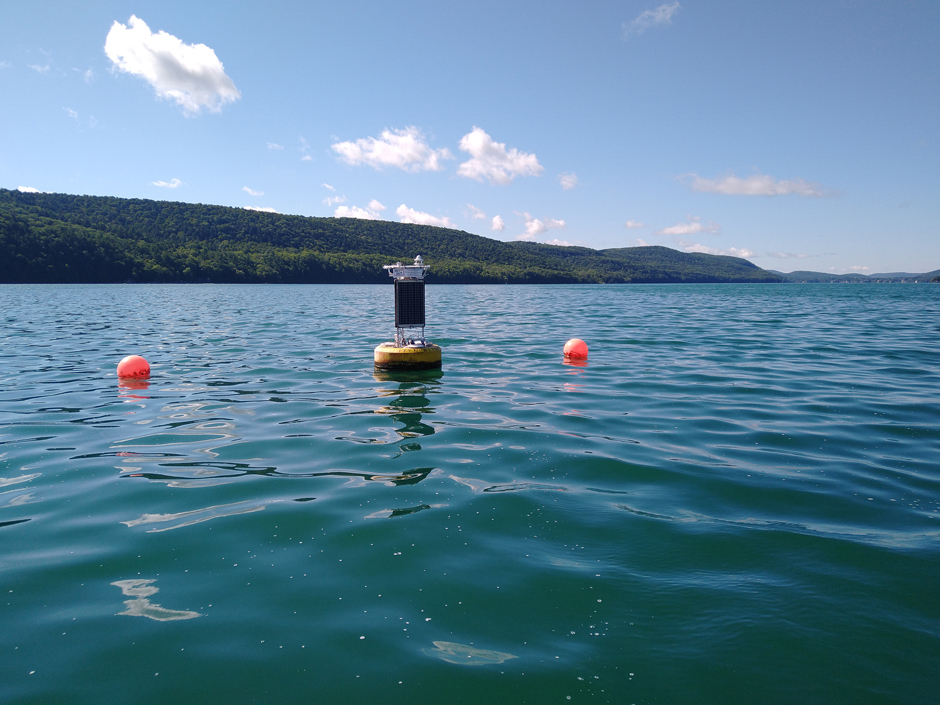 Data buoy in seemingly clean water, but the white foamy scum on the water surface contained high concentrations of cyanobacteria (MIcrocystis aeruginosa). (Credit: Kiyoko Yokota)
Data buoy in seemingly clean water, but the white foamy scum on the water surface contained high concentrations of cyanobacteria (MIcrocystis aeruginosa). (Credit: Kiyoko Yokota)Throughout the years, harmful algal blooms (HABs) in the Laurentian Great Lakes have been meticulously documented and closely studied due to their annual appearance across the basin. While these blooms have become a recurrent issue in the Great Lakes region, many lakes worldwide are now facing harmful algal blooms for the very first time, with some causes still unknown.
Otsego Lake is one example of a lake that experienced its first harmful algal bloom in 2022, leaving state agencies and researchers to wonder what triggered the event. Kiyoko Yokota, an associate professor of biology with the State University of New York (SUNY) at Oneonta, is the lead researcher of the project.
Serving as the current president of the North American Lake Management Society, scientific advisor for the Otsego Lake Watershed Supervisory Committee and technical advisor for the Otsego Lake Association, Yokota is familiar with harmful algal blooms and the significance of Otsego Lake for the surrounding community.
On the southern end of Otsego Lake is the beautiful Village of Cooperstown, which houses the National Baseball Hall of Fame and Museum and welcomes numerous baseball fans from around the world, especially around the induction weekend in late July. Scattered around the lake are other cultural institutions, including Fenimore Art Museum, the Farmer’s Museum, Glimmerglass Opera, and Hyde Hall.
Glimmerglass State Park is a full-service state park with a visitor center, trails, campgrounds, picnic areas, a swimming beach with a lifeguard, and canoe and kayak rental, providing affordable, family-friendly outdoor recreation opportunities for all. Bassett Medical Center in Cooperstown is the medical hub that serves the entire Otsego County and surrounding communities, and the natural and cultural resources around Otsego Lake facilitate the recruitment and retention of highly qualified professionals from around the world.
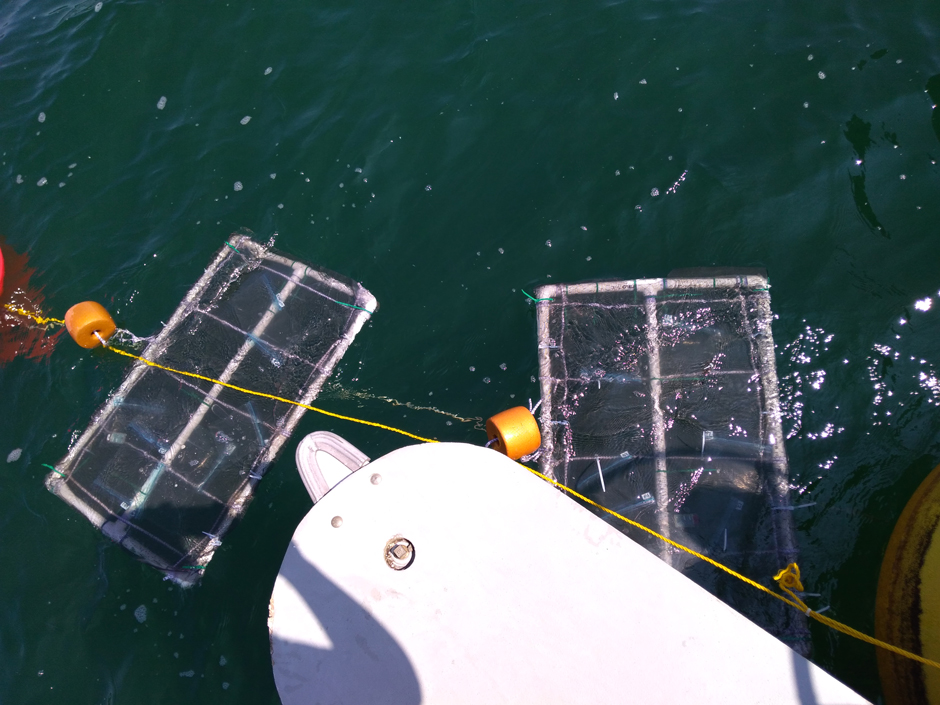
A microcosm experiment in summer 2019 as part of a multi-lake nutrient limitation study through GLEON. The floating PVC frames housed 8 plastic bags that acted as microcosms (small experimental units incubated in the real lake environment). (Credit: Kiyoko Yokota)
Yokota splits her time among teaching, office work, and fieldwork—a habit that runs in her family. “My father studied silviculture and forest management in college, and he split his time between fieldwork, teaching foresters techniques and management plans, and administrative work at the prefectural government office, which included regular business trips to Tokyo for meetings at the national forestry agency. He always seemed happier when he was working in the field,” explains Yokota.
Fond memories of days spent fishing with her father and an interest in being able to protect nature are what drove Yokota to pursue a career focusing on lakes and estuaries. Most recently, Yokota has been working alongside the New York State Department of Environmental Conversation (NYSDEC) to develop the Nine Element Plan, a comprehensive lake and watershed management plan.
The program began in partial response to the cyanobacterial bloom on Otsego Lake in 2022 as the first HAB event led to others, with recurring toxigenic blooms that interfered with beach activities and overall ecosystem health. In response to the event, the NYSDEC and NYS Federation of Lake Associations (NYSFOLA) added Otsego Lake to their Citizens Statewide Lake Assessment Program (CSLAP) in order to help gather more data on the aquatic system.
SUNY Oneonta is a primarily undergraduate university, so Yokota’s research team does not include postdocs, Ph.D. students or lab techs. Instead, the community aspect, involving both SUNY Oneonta students and local residents, becomes an important part of monitoring the lake. Yokota helps CSLAP volunteers collect water samples and assess water clarity with a Secchi disk and simultaneously collects water quality data with a sonde and measures underwater irradiance with a light sensor to make the most out of each sampling event.
In addition to the discrete sampling by students, volunteers and fellow researchers, Yokota uses NexSens Technology to gather real-time data on the lake. A grant funded by the National Science Foundation’s Field Station and Marine Lab Program helped Yokota purchase a CB-950 data buoy for Otsego Lake, which supplemented the long-term biweekly manual sampling program by SUNY Oneonta Biological Field Station staff.
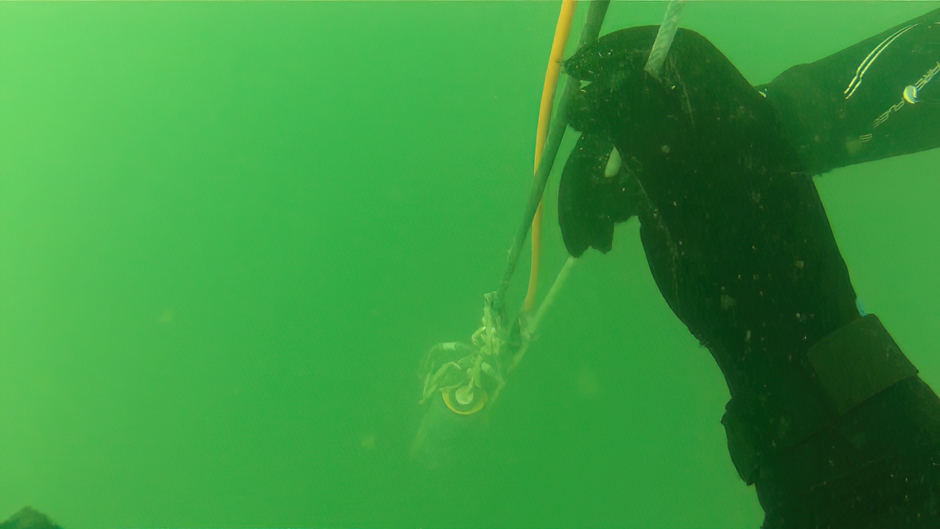
A Biological Field Station Volunteer Dive Team member, Alex Sessions, checking the data cable (black) and the thermistor array (orange cable) underwater. (Credit: Alex Sessions)
The buoy, equipped with an X2-CB data logger and two YSI EXO2 sondes daisy chained at two depths, collect water quality data to capture the annual establishment and disappearance of summer stratification of the water column—with warmer water at the surface (epilimnion) and cooler water at the bottom (hypolimnion). The buoy is also equipped with both a Lufft WS600 and an Airmar 200WX-IPX7 to gather weather data and develop a more comprehensive image of what is impacting the lake.
The sondes are each equipped with a temperature, conductivity, dissolved oxygen and pH sensor. Due to the differences in light, only the top sonde is equipped with two additional sensors that measure total algae and fluorescent dissolved organic matter.
All of the data collected by the sensors is logged in the X2 and then transferred to the cloud, where it is accessible through WQData LIVE, making data analysis and monitoring easy for busy researchers like Yokota. Without having to leave campus, Yokota can sign onto WQData LIVE and see what is happening at the lake. The accessibility and long-term data capabilities the X2 provides came at the perfect time for the lake.
She explains, “When I first got the buoy, I was more or less like, ‘Oh, long-term high-frequency data would be useful for various studies.’ Because you can compare the background water quality and weather information from the buoy with whatever you might observe or manipulate. But now we have the long-term high-frequency data before and after the lake started to bloom.”
Data-Driven Management in Otsego Lake
When Yokota was first in the market for a data buoy in 2015, she knew that the system would have to be compatible with her busy teaching schedule as well as largely self-sufficient, as frequent trips to the buoy for system maintenance are not possible due to the distance between the main campus and the lake.
She explains, “My local Global Lake Ecological Observatory Network (GLEON) collaborators, who were also faculty at primarily undergraduate institutions (PUIs), spoke highly of NexSens buoys that they had used. Also the combination of a stationary thermistor string and sondes was recommended as it involves fewer moving parts and therefore more manageable than vertical profiling buoys – a very important factor for researchers at PUIs who typically teach 3-4 courses per semester.”
Yokota continues, “I was so excited when our proposal was funded, and Paul Nieberding helped me place the order and helped me keep track of different parts that came in separate shipments. Justin Walters has been super helpful—so many times he helped me over the phone while I was on a boat next to the buoy in the middle of the lake and gave me step-by-step guidance while he was able to check real-time data on his side. I have yet to meet Justin in person, but it feels like he is part of my lab!”
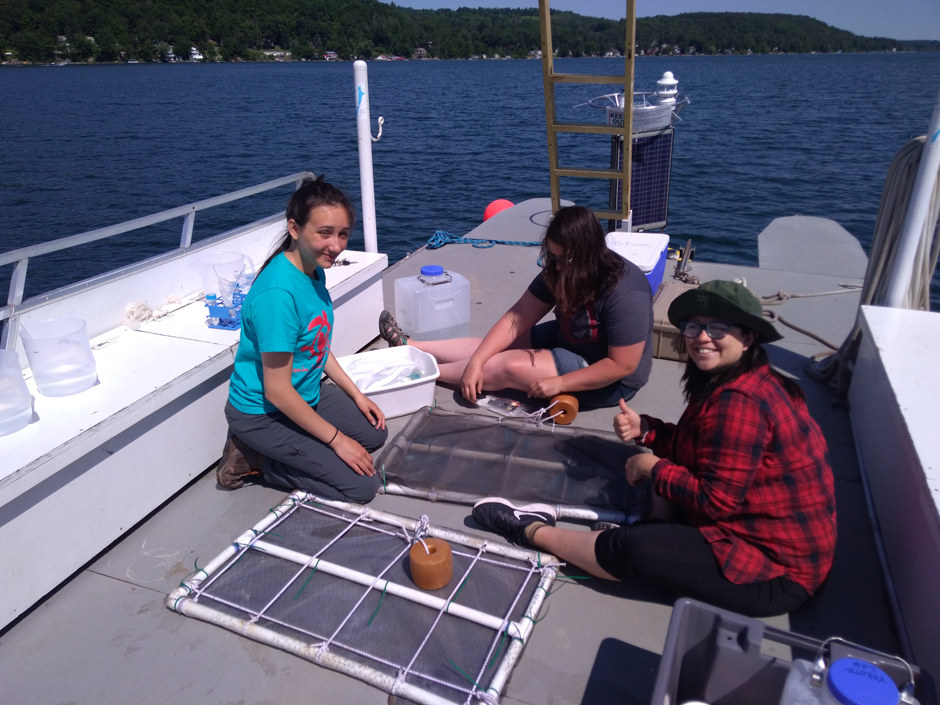
SUNY Oneonta students and an international summer intern setting up the microcosm experiment. (Credit: Kiyoko Yokota)
Having access to high-frequency water quality and weather data greatly facilitates lake modeling. NYEDEC’s Nine Element Plan includes modeling of the Otsego Lake watershed and the lake itself, using the Chesapeake Assessment Scenario Tool (CAST) model by the Chesapeake Bay Program and a modified CE-QUAL-W2 model by the Upstate Freshwater Institute.
“CE-QUAL-W2 is a two-dimensional model originally developed by Portland State University. Once the nutrients and sediment come into a lake, do they move horizontally and flow out of the lake? Or are they going to settle to the bottom? The high-frequency water temperature and wind data from the buoy greatly assist the modelers with simulating the complex and weather-dependent movements of imaginary parcels of water within a lake, which also dictate the movement of nutrients and sediment in those parcels,” explains Yokota.
She continues, “Then the model addresses how much of the nutrients are going to feed the phytoplankton, what kind of phytoplankters are likely to flourish (diatoms vs. cyanobacteria, for example) and by how much, and then how that affects light availability within the water column, and so on.”
Combined, the CAST and CE-QUAL-W2 models will predict lake water quality resulting from various watershed management scenarios. This will allow local stakeholders to consider Otsego Lake and its watershed as a whole and evaluate various potential watershed and in-lake management strategies using the model predictions.
The modeling will also enable objective and consistent assessment of the effectiveness of the selected management actions by comparing the modeled vs. observed outcomes, an important element of all NYSDEC Nine Element Plans. Such assessment is essential for periodic revisions of the management plan to keep moving towards the lake and watershed management goal.
For example, a community may have funding for one watershed project but not two. The models will simulate how reductions in agricultural runoff vs. septic discharge affect the chlorophyll concentration in a lake. The community will then be able to prioritize projects based on the predicted chlorophyll concentrations.
After the nutrient load reduction is achieved, the actual chlorophyll concentrations will be compared to the predicted values to assess the effectiveness of the project. This model-based approach allows more comprehensive and data-driven protection of natural resources.
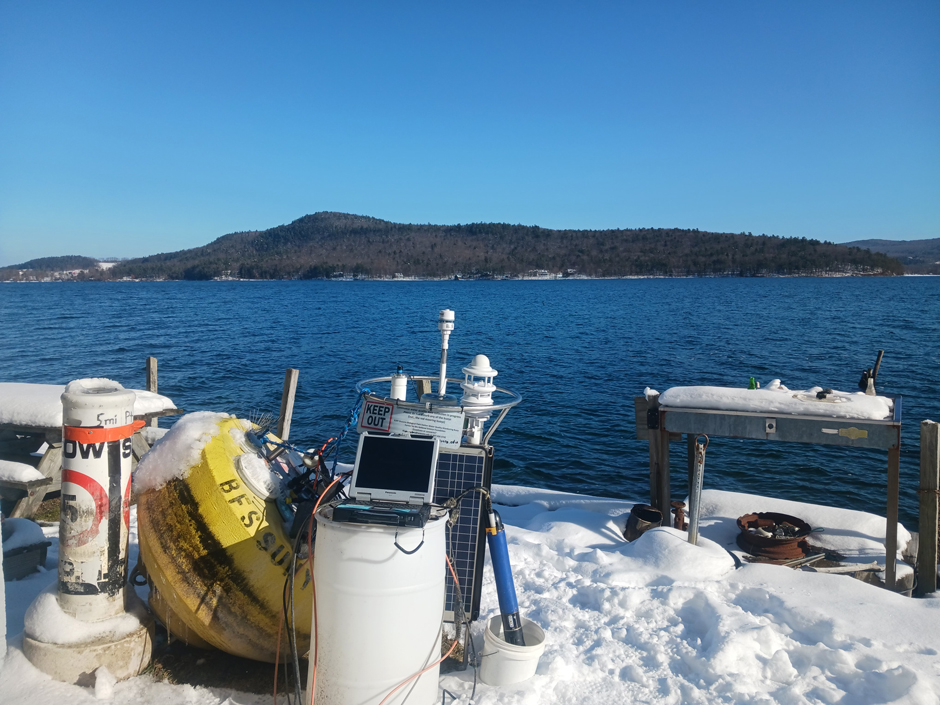
Testing the whole system with the new Airmar weather station. (Credit: Kiyoko Yokota)
Conclusion
Local initiative and regulations have led to declines in agricultural and septic runoff, though the lake is still impacted by a number of invasive species, including zebra and quagga mussels, which are reported to have contributed to cyanobacterial blooms in many temperate lakes in North America and Western Europe.
Both species are known to change food webs and system dynamics as they over-filter the water, increasing water clarity and light penetration, which disrupts native species and can promote benthic growth of filamentous algae and/or cyanobacteria. “It’s kind of deceiving because the lake looks cleaner than before, but then we start to have the harmful algal or cyanobacterial blooms,” states Yokota.
In recent decades, Otsego Lake has gone from mesotrophic to oligotrophic, with medium to low productivity, while cyanobacterial blooms have long been treated as indicators of eutrophication and increased productivity.
Many lakes, including those in Upstate New York, such as Skaneateles Lake and Lake George, are affected by cyanobacterial blooms despite being oligotrophic. The overall nutrient input from the watershed has generally been stable or reduced over time. Because the exact cause of the harmful algal blooms in Otsego Lake is still unknown, continuous real-time monitoring will help to observe conditions over time and potentially conclude what is causing the harmful algal blooms.
Otsego Lake is a part of GLEON, and as such, the data collected by the buoy deployed there and the discrete measurements conducted by Yokota have been shared with a community of researchers. Likewise, she has the support of the network’s data to support her research as well.
“Working with community-minded researchers who respect the GLEON mantra of data sharing and equitable collaboration has been extremely inspiring and rewarding,” states Yokota.
Like many other lakes, Otsego Lake is one of many included in the list of lakes that have begun to experience algal blooms. Research gathered by the buoy-based system will not only improve NYSDEC’s local Nine Element Plans, but the data can also help support limnological research elsewhere.
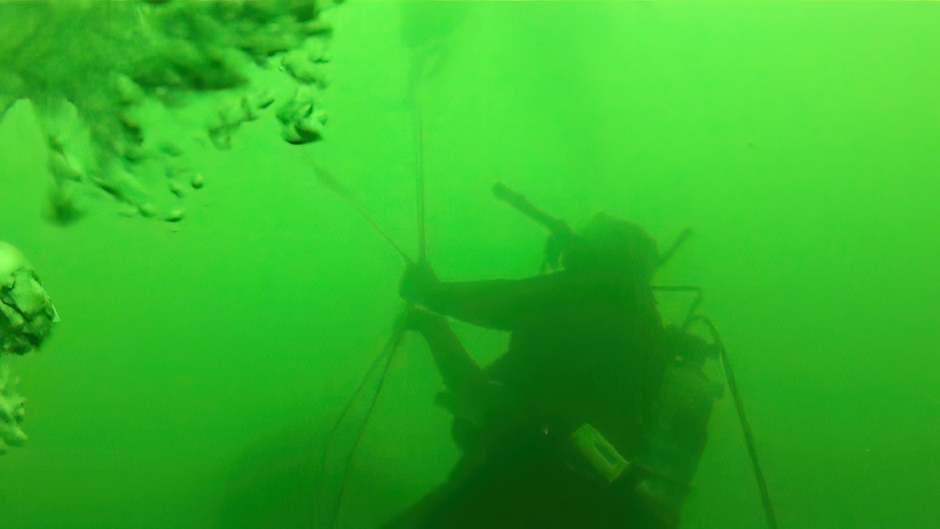
A Biological Field Station Volunteer Dive Team Dive Master LtCol Paul H. Lord checking the underwater cables hanging from the data buoy.
(Credit: Alex Sessions)




0 comments